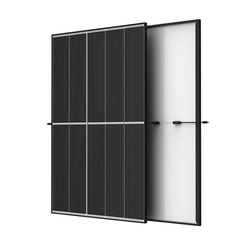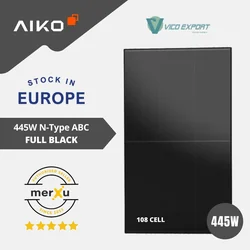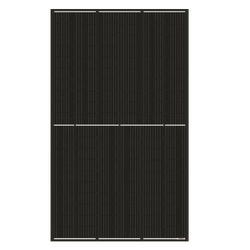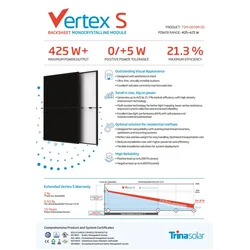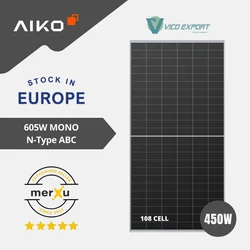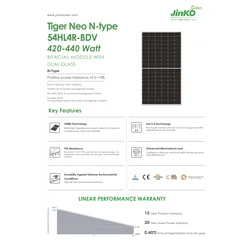
New Generation of Photovoltaic Modules
Innovations in Silicon Technology
1. Distinguishing N-Type and P-Type Cells: Choosing in Photovoltaics
Photovoltaic cells, pivotal in the industry, are evolving rapidly, introducing innovations such as N-type cells. Let's explore how they differ from the widely used P-type cells.
History and Application of N-Type and P-Type Technology
Paradoxically, despite the earlier appearance of N-type cells, P-type cells dominate the market, constituting up to 90% of available solutions. Initially reserved for the aerospace industry due to their greater resistance to cosmic radiation, N-type technology gave way to P-type cells due to higher costs as the photovoltaic industry developed.
Structure of N-Type and P-Type Cells: How They Work
N-Type and P-Type cells utilize doping with elements (phosphorus and boron) in silicon, introducing differences in their polarization. In the case of P-Type cells, the silicon base is positively polarized, attracting negatively charged electrons. On the other hand, N-Type cells have a negatively polarized base, resulting in the movement of atoms from the negative to the positive part of the cell.
Efficiency and Performance
N-Type cells stand out with higher efficiency, reaching up to 22.1%, compared to the maximum 24.5% of P-Type cells. Moreover, forecasts indicate the potential for N-Type cells to achieve efficiencies of up to 28.7%.
Longevity and Temperature Coefficient
N-Type cells undergo less degradation caused by light, thanks to the use of phosphorus instead of boron. They are also more resistant to contaminants, making them more durable. Additionally, N-Type cells achieve significantly lower temperatures on hot days, impacting their efficiency and reliability.
Cost vs. Popularity
Despite higher efficiency, N-Type cells are currently more expensive than P-Type cells, which enjoy greater popularity and simpler production technology. However, with predicted price drops, N-Type modules are gaining popularity among leading manufacturers, potentially leading to a complete technology shift in the future.
2. Are Photovoltaic Panels Made of Glass? Glass-Glass Technology
Characteristics of Glass-Glass Modules
Glass-Glass modules stand out with an innovative approach to construction, where the lower part of the module does not contain the traditional EVA material layer but instead has a second glass layer. This construction, initially used mainly for thin-film modules, found new application, revolutionizing the field of photovoltaic modules.
Construction of Glass-Glass Modules
The construction of Glass-Glass modules is relatively simple, consisting of five layers of material. Thick glass panes form the first and last layers, providing high mechanical resistance. Instead of EVA, successive layers (the second and fourth) are composed of a film serving as an encapsulating material. The use of this special film translates to a reduction in the degradation rate of modules, making Glass-Glass modules less prone to performance drops compared to traditional PV modules.
Advantages and Benefits
A crucial benefit of Glass-Glass modules is their extended warranty, often reaching up to 30 years. Glass-Glass modules not only reduce performance degradation but also open doors to innovative solutions. An example includes bifacial modules, capable of absorbing radiation from both the front and back of the module. This is another advantage that allows the partial conversion of reflected light into electrical energy, increasing the efficiency of the photovoltaic installation.
3. What are Shingled Modules?
Shingled technology represents a revolution in photovoltaics, although its roots date back to space applications. Today's version of this technology is a response to the growing need for the efficiency of photovoltaic modules. Shingled allows achieving higher power density while maintaining competitive costs compared to traditional PV modules.
Construction and Advantages of Shingled Technology
Cells in Shingled technology are laid on top of each other like shingles, not only increasing power density but also minimizing resistive losses. The use of laser cutting of cells into long strips and layering with a specially conductive adhesive results in individual busbars hidden under the interconnections, eliminating the risk of shading. Such a connection translates to a larger working surface of the panels, particularly noticeable during morning and evening hours, where Shingled modules can achieve up to 87% of their production.
Benefits of Implementing Shingled Technology
Lower Ohmic Losses: Parallel connection of cells and their small contact surface result in lower resistance, minimizing energy losses. This is significant for the flow of electric current, minimizing energy loss.
Lower Module Operating Temperature: Lower electrical resistance also means a lower operating temperature of the module, promoting electricity production. Lower temperature has a positive impact on the panel's lifespan, eliminating issues related to overheating.
Resistance to PID and LID Effects: Shingled technology reduces PID (Potential Induced Degradation) and LID (Light-Induced Degradation) effects, ensuring stable module performance.
No Hotspots: Eliminating the risk of hotspots, areas with excessively high temperature, results in safe and stable module operation, minimizing the risk of damage and fires.
Efficient Use of Surface: The dense arrangement of photovoltaic cells allows for better utilization of the surface, translating to higher power density and space and cost savings.
Shingled technology not only enhances the efficiency of photovoltaic modules but also aligns with the trend of innovative solutions, providing durability, safety, and savings for investors.
We mention only a few of the existing technologies that are of interest in the market. If you are interested in more, you can explore the full spectrum of offerings on merXu.com.
Top-Angebote


Jinko JKM470N-60HL4-V, Jinko 470 Ntype schwarzer Rahmen

Photovoltaikmodul PV-Panel 435Wp Longi Solar LR5-54HTH-435M Hi-MO 6 Explorer Black Frame Schwarzer Rahmen

Jinko Photovoltaikmodul 480 480W JKM480N-60HL4-V BF
JINKO 480W N-TYPE JKM480W-60HL4-V BF
Conclusion
Reviewing the novelties in photovoltaic technology, it's challenging not to notice the dynamic development of the sector. On one hand, we have the stable dominance of PV modules made in silicon technology, capable of mass production and widely available due to competitive prices. On the other hand, innovations in N-type cells, Glass-Glass modules, Shingled technology, and perovskites suggest that the industry is constantly striving to increase efficiency, durability, and sustainability.
It's also worth noting that the choice between different technologies is not only about efficiency but also about costs, market availability, and future prospects. It's challenging to predict which of these technologies will ultimately dominate the market, but the development in perovskites, with their potential to revolutionize photovoltaics, seems particularly fascinating. [Read about Perovskites HERE]
In summary, observing progress in solar energy provides hope for a more sustainable and efficient energy future. May these innovations contribute to a more widespread and accessible use of solar energy worldwide.
